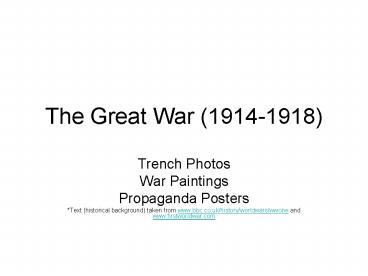The Great War 19141918 - PowerPoint PPT Presentation
1 / 67
Title:
The Great War 19141918
Description:
Text (historical background) taken from www.bbc.co.uk/history/worldwars/wwone ... War, although well documented photographically, also inspired painters from ... – PowerPoint PPT presentation
Number of Views:54
Avg rating:3.0/5.0
Title: The Great War 19141918
1
The Great War (1914-1918)
- Trench Photos
- War Paintings
- Propaganda Posters
- Text (historical background) taken from
www.bbc.co.uk/history/worldwars/wwone and
www.firstworldwar.com
2
Total War
- A new kind of war
- World War One was like no other war before in
history. The main theatre of war, the Western
Front, was deadlocked from a few months after the
war's start in 1914 until a few months before its
end in 1918, stretching in a continuous line of
trenches from the English Channel to the Swiss
frontier. By 1916 the forces of Germany, France
and the British Empire, armies millions of men
strong, measured advances in terms of a few miles
(or kilometers) gained over several months.
Casualties for each big attack or 'push' ran into
hundreds of thousands on both sides, with
calculations for victory based on national
birth-rates to replace the losses. This was not
the kind of war that anyone, including the
politicians and generals who directed it, wanted
to fight. - What made World War One so different was the
long-term impact of the Industrial Revolution,
with its accompanying political and social
changes. This was the first mass global war of
the industrialized age, a demonstration of the
prodigious strength, resilience and killing power
of modern states. The war was also fought at a
high point of patriotism and belief in the
existing social hierarchy beliefs that the war
itself helped destroy, and that the modern world
finds very hard to understand.
3
The Trenches
- The First World War was typified however by its
lack of movement, the years of stalemate
exemplified on the Western Front from autumn 1914
until spring 1918. Once the trenches were dug,
they were fought over, captured, abandoned, and
retaken multiple times. - In addition to worrying about being shot by a
sniper or shelled, there were other, more
immediate concerns for the soldiers, including
rats, lice, frogs, Trench Fever, Trench Foot
(serious fungal outbreaks), etc. - Trenches were built/constructed differently
depending on the landscape and available
materials. - The following photos are a very small sample of
the massive visual data available on
http//www.firstworldwar.com.
4
French Grenadiers/ Trench Camouflage
5
Trench Clearing/ Captured German Trench
6
Barbed Wire Defenses/French Troops Firing Over
Their Own Casualties
7
German trench in Africa/Early French Trenches
8
Antwerp guns/Bombproof shelter
9
French first-aid/Trench building
10
German Trench/Royal Irish Fusiliers
11
Argonne Dead and Wounded/French gunners
12
Captured German troops/Trench View
13
Van defense
14
War dog!
15
Painting
- The Great War, although well documented
photographically, also inspired painters from
across the world to represent the horrors they
personally witnessed while serving their
countries.
16
Alfred Kubin Die Kriegsfackel (The Torch) 1914
17
Max Beckmann Der Kriegsaubruch (Declaration of
War) 1914
18
C.R.W. Nevinson A Bursting Shell 1915
19
C.R.W. Nevinson The Harvest of Battle 1919
20
Edward Alexander Wadsworth Dazzled-Ships in
Drydock in Liverpool 1919
21
Erik Heckel Zwei Verwundete (Two Wounded
Soldiers) 1915
22
Eric Kennington Gassed and Wounded 1919
23
Felix Vallotton Le cimetiere de
Chalons-sur-Marne 1917
24
Felix Vallotton Le plateau de Bolante 1917
25
George Grosz Explosion 1917
26
George Leroux LEnfer (Hell) 1917-18
27
John Lavery The Cemetery, Etaples 1919
28
John Nash Oppy Wood 1917
29
John Singer Sargent A Street in Arras 1918
30
John Singer Sargent Gassed 1918-19
31
Marcel Gromaire Le guerre (War) 1925
32
Max Beckmann Die Granate (Shell) 1915
33
Max Beckmann Die Operation 1914
34
Max Edler von Poosch Kaupstaffel D3 uber der
Brent-Gappe (Squadron over the Brent-Gappe) 1917
35
Oskar Kokoschka Isonzo-Front (The front at
Isonzo) 1916
36
Ossip Zadkine Loude 1916
37
Otto Dix Lichtsignale (The Flare) 1917
38
Pablo Picasso Appollinaire blesse (Appollinaire
wounded) 1916
39
Pablo Picasso Guillaume de Kostrowitzky 1914
40
Paul Nash A Howitzer Firing
41
Paul Nash Night Bombardment 1918-19
42
Paul Nash The Ypres Salient at Night 1917-18
43
Percy Wyndham Lewis A Battery Shelled 1919
44
Pierre Bonnard Un village en ruines pres du Ham
1917
45
William Orpen Thiepval 1917
46
William Orpen To the Unknown British Soldier
killed in France 1922-27
47
Propaganda Posters
- Each of the nations which participated in World
War One from 1914-18 used propaganda posters not
only as a means of justifying involvement to
their own populace, but also as a means of
procuring men, money and resources to sustain the
military campaign. - However wartime posters were not solely used to
recruit men to the military cause. Posters
commonly urged wartime thrift, and were vocal in
seeking funds from the general public via
subscription to various war bond schemes (usually
with great success). - Interestingly, for all that the U.S.A. joined the
war relatively late - April 1917 - she produced
many more propaganda posters than any other
single nation.
48
- France
49
(No Transcript)
50
(No Transcript)
51
Deutschland
52
(No Transcript)
53
(No Transcript)
54
Italia
55
(No Transcript)
56
The Russian Empire
57
(No Transcript)
58
Great Britain
59
(No Transcript)
60
(No Transcript)
61
(No Transcript)
62
The United States
63
(No Transcript)
64
(No Transcript)
65
(No Transcript)
66
(No Transcript)
67
(No Transcript)































